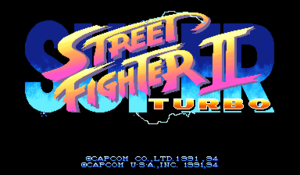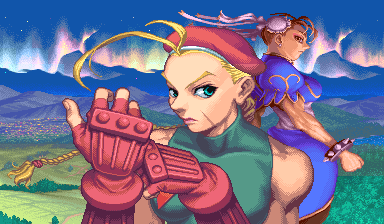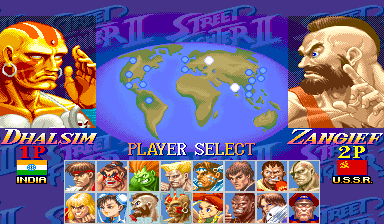ReckyDaGuy (talk | contribs) (Edited the infobox with more accurate information and edited the introduction paragraph to flow better.) |
|||
| Line 1: | Line 1: | ||
{{Infobox Game | {{Infobox Game | ||
| gamename = Super Street Fighter II Turbo | | gamename = Super Street Fighter II Turbo | ||
| abbreviation = ST | | abbreviation = ST, SSFIIT, SSFIIX | ||
| image = Ssfiitlogo.png | | image = Ssfiitlogo.png | ||
| image2 = Stintro.png | | image2 = Stintro.png | ||
| image3 = STselect.png | | image3 = STselect.png | ||
| developer = Capcom | | developer = Capcom | ||
| system = CPS-II<br>NA: February 23, 1994<br>JP: February 23, 1994<br>EU: February 23, 1994<br>AS: February 23, 1994<br>AU: February 23, 1994<br>NA: March 23, 1994 (latest/beta)<br>EU: March 1994 (latest/beta) | | system = CPS-II (Arcade)<br>NA: February 23, 1994<br>JP: February 23, 1994<br>EU: February 23, 1994<br>AS: February 23, 1994<br>AU: February 23, 1994<br>NA: March 23, 1994 (latest/beta)<br>EU: March 1994 (latest/beta) | ||
| system2 = 3DO<br>NA: November 7, 1994<br>JP: November 14, 1994<br>AU: November 21, 1994<br>EU: November 23, 1994 | | system2 = 3DO<br>NA: November 7, 1994<br>JP: November 14, 1994<br>AU: November 21, 1994<br>EU: November 23, 1994 | ||
| system3 = PC-DOS<br>NA: May 5, 1995<br>AU: June 1, 1995<br>EU: June 2, 1995 | | system3 = PC-DOS<br>NA: May 5, 1995<br>AU: June 1, 1995<br>EU: June 2, 1995 | ||
| system4 = Amiga<br>EU: 1995 | | system4 = Amiga<br>EU: 1995 | ||
| system5 = Sega Saturn<br>JP: September 18, 1997<br>NA: November 30, 1997<br>EU: 1997 | | system5 = Sega Saturn (Street Fighter Collection)<br>JP: September 18, 1997<br>NA: November 30, 1997<br>EU: 1997 | ||
| system6 = PS1/PSX<br>JP: October 23, 1997<br>NA: November 30, 1997<br>EU: July, 1998 | | system6 = PS1/PSX (Street Fighter Collection)<br>JP: October 23, 1997<br>NA: November 30, 1997<br>EU: July, 1998 | ||
| system7 = Dreamcast<br>JP: December 22, 2000 | | system7 = Dreamcast (For Matching Service)<br>JP: December 22, 2000 | ||
| system8 = Game Boy Advance<br>JP: July 13, 2001<br>NA: October 30, 2001<br>AU: November 1, 2001<br>EU: November 2, 2001 | | system8 = Game Boy Advance (Turbo Revival)<br>JP: July 13, 2001<br>NA: October 30, 2001<br>AU: November 1, 2001<br>EU: November 2, 2001 | ||
| system9 = PS2<br>NA | | system9 = PS2 (Capcom Classics Collection Volume 2)<br>NA: November 24, 2006<br>EU: April 13, 2007<br>AU: April 11, 2007 | ||
| system10 = Xbox<br>NA | | system10 = Xbox (Capcom Classics Collection Volume 2)<br>NA: November 14, 2006 | ||
| system11 = | | system11 = PS3 (Super Street Fighter II Turbo HD Remix)<br>NA: November 25, 2008<br>EU: February 19, 2009 | ||
| system12 = | | system12 = Xbox 360 (Super Street Fighter II Turbo HD Remix)<br>NA: November 26, 2008 | ||
| system13 = PC/PS4/Xbox One/Switch (30th Anniversary)<br>:2018 | | system13 = PC/PS4/Xbox One/Switch (Street Fighter 30th Anniversary Collection)<br>JP: 25 October 2018<br>WW: 29 May 2018 | ||
| netcode = FightCade (PC)<br>HDR | |||
| netcode = FightCade (PC, rollback)<br>HDR Classic Mode (PS3/Xbox 360, delay based)<br>SF30th (PC/PS4/XBox One/Switch, delay based) | |||
}} | }} | ||
[[Image:Stintro.png|class=st-screen|Attract Mode]] | [[Image:Stintro.png|class=st-screen|Attract Mode]] | ||
| Line 26: | Line 27: | ||
==Introduction== | ==Introduction== | ||
Super Street Fighter II Turbo, or Super Street Fighter II X: Grand Master Challenge in Japan, is the fifth revision of Street Fighter II. | To many, this game needs no introduction. | ||
Super Street Fighter II Turbo, or Super Street Fighter II X: Grand Master Challenge in Japan, is the fifth revision of Street Fighter II. This version builds upon the foundations set by the previous versions (Street Fighter II: The World Warrior, Street Fighter II': Champion Edition, Street Fighter II': Hyper Fighting ("Turbo" in Japan), and Super Street Fighter II: The New Challengers) with balance changes, new moves, and new features to polish an already revolutionary title into a game that stands the test of time. | |||
Street Fighter II: The World Warrior was released in 1991 by Capcom for the CPS-1 arcade board and completely revolutionized gaming. People were used to competing against the CPU for high scores, and most two-player games were cooperative, such as Double Dragon or Final Fight. Street Fighter II presented eight selectable characters - a high number by that time - that people could use not only against the CPU, but to face other human opponents. While | Street Fighter II: The World Warrior was released in 1991 by Capcom for the CPS-1 arcade board and completely revolutionized the gaming scene. People were used to competing against the CPU for high scores, and most two-player games were cooperative, such as Double Dragon or Final Fight. Street Fighter II presented eight selectable characters - a high number by that time - that people could use not only against the CPU, but to face other human opponents. While Street Fighter II was not the first game with features such as fighting against another human, multiple playable characters, or even combos, it took all the good ideas previous fighting games created and created a fighting game that completely trounced any competition that came before it. And while it was considered one of the best arcade games for a while, it did have a few notable glitches, and players could not select the same character at the same time. Reversal specials were impossible, with a perfectly timed input resulting in a normal move on the reversal frame (or nothing if performed by negative edge). This made safe jumps into tick throws exceedingly strong, as the only chance to escape was via reversal throw. This was extremely difficult due to the opponent being able to mix up by doing jabs, twice, once, or none at all after the jump in, and throws being a 50/50 chance of success when both players throw on the same frame. | ||
Street Fighter II': Champion Edition was released in 1991 and had a number of improvements. | Street Fighter II': Champion Edition was released in 1991 and had a number of improvements. Four boss characters previously inaccessible to players were made playable, which expanded the game's depth greatly. Reversal special attacks were also fixed and many moves were adjusted for improved balance, with a few extra command normals added for Guile and Chun-Li. In addition, many in-game graphics were redrawn, such as character portraits, endings, and some animations. | ||
In 1992, Capcom released Street Fighter II' Hyper Fighting, or Street Fighter II Turbo in Japan. This was Capcom's response to the several bootleg versions of Champion Edition which were getting spread around the world. The game speed was increased, characters were given extra moves and some special attacks were allowed to be used in the air. The game has also been adjusted for improved balance. This was the last Street Fighter game released to the CPS-1 board. | In 1992, Capcom released Street Fighter II' Hyper Fighting, or Street Fighter II Turbo in Japan. This was Capcom's response to the several bootleg versions of Champion Edition which were getting spread around the world. The game speed was increased, many characters were given extra moves, and some special attacks were allowed to be used in the air. The game has also been adjusted for improved balance. This was the last Street Fighter game released to the CPS-1 board. | ||
Capcom released Super Street Fighter II: The New Challengers in 1993 together with a new, more powerful hardware: the CPS-2. The new board used data encryption to prevent piracy and bootleg versions such as the ones based on Champion Edition. The game came with reworked music, different voices for the announcer and most characters, new sound effects, redrawn graphics for the stages, redrawn character animations for a few attacks, extra win pose animations, the introduction of combo counters, bonuses for using reversals and attacking the enemy first and, finally, four new playable characters. On the other hand, the speed had been again reduced to that of the original two versions, which was a turn-off to Hyper Fighting fans. | Capcom released Super Street Fighter II: The New Challengers in 1993 together with a new, more powerful hardware: the CPS-2 arcade board. The new board used data encryption to prevent piracy and bootleg versions such as the ones based on Champion Edition. The game came with reworked music, different voices for the announcer and most characters, new sound effects, redrawn graphics for the stages, redrawn character animations for a few attacks, extra win pose animations, the introduction of combo counters, bonuses for using reversals and attacking the enemy first and, finally, four new playable characters. On the other hand, the speed had been again reduced to that of the original two versions, which was a turn-off to Hyper Fighting fans. | ||
In 1994, Capcom released Super Street Fighter II Turbo for the CPS-2. The speed had again been increased, all characters had moves adjusted for balance and new special and normal attacks were added. | In 1994, Capcom released Super Street Fighter II Turbo for the CPS-2. The speed had again been increased, all characters had moves adjusted for balance and new special and normal attacks were added. For the first time, the pervious iteration of each character from Super Street Fighter II was available to play as through codes which could be used after selecting the character, effectively doubling the number of characters from the previous game. (This idea would be expanded upon in the next iteration, Hyper Street Fighter II: The New Challengers.) Additionally, a secret final boss was introduced, Akuma, and a toned down version was available for players to use with a more complicated code. Finally, a new type of special move was introduced: the ''Super Combo''. While they have "combo" in the name, some of them are not actually combos. We shall refer to these moves as ''super moves'' instead, or simply ''super''. These super moves could only be used after the small bar at the bottom of the screen were filled, but they did high damage and often had special properties such as periods of invulnerability, the ability to combo even if the enemy was in the air (so-called juggle combos), or the ability to erase incoming projectiles. | ||
Super Street Fighter II Turbo has been played competitively since | Despite many decades passing and a deluge of new fighting games to play, Super Street Fighter II Turbo has been played competitively since its release and has been featured in countless major fighting game tournaments, such as the Evolution Championship Series/EVO and SBO/Tougeki. To this day, it is a beloved old-school game and still recognized by many professional-level players as one of the best fighting games of all time. | ||
<youtube>lb9jshbCKtk</youtube> | <youtube>lb9jshbCKtk</youtube> | ||
Revision as of 05:10, 10 November 2022
| Super Street Fighter II Turbo (ST, SSFIIT, SSFIIX) | |
|---|---|
| Developers |
Capcom |
| Systems |
CPS-II (Arcade) |
| 3DO NA: November 7, 1994 JP: November 14, 1994 AU: November 21, 1994 EU: November 23, 1994 | |
| PC-DOS NA: May 5, 1995 AU: June 1, 1995 EU: June 2, 1995 | |
| Amiga EU: 1995 | |
| Sega Saturn (Street Fighter Collection) JP: September 18, 1997 NA: November 30, 1997 EU: 1997 | |
| PS1/PSX (Street Fighter Collection) JP: October 23, 1997 NA: November 30, 1997 EU: July, 1998 | |
| Dreamcast (For Matching Service) JP: December 22, 2000 | |
| Game Boy Advance (Turbo Revival) JP: July 13, 2001 NA: October 30, 2001 AU: November 1, 2001 EU: November 2, 2001 | |
| PS2 (Capcom Classics Collection Volume 2) NA: November 24, 2006 EU: April 13, 2007 AU: April 11, 2007 | |
| Online Play |
FightCade (PC, rollback) |
Introduction
To many, this game needs no introduction.
Super Street Fighter II Turbo, or Super Street Fighter II X: Grand Master Challenge in Japan, is the fifth revision of Street Fighter II. This version builds upon the foundations set by the previous versions (Street Fighter II: The World Warrior, Street Fighter II': Champion Edition, Street Fighter II': Hyper Fighting ("Turbo" in Japan), and Super Street Fighter II: The New Challengers) with balance changes, new moves, and new features to polish an already revolutionary title into a game that stands the test of time.
Street Fighter II: The World Warrior was released in 1991 by Capcom for the CPS-1 arcade board and completely revolutionized the gaming scene. People were used to competing against the CPU for high scores, and most two-player games were cooperative, such as Double Dragon or Final Fight. Street Fighter II presented eight selectable characters - a high number by that time - that people could use not only against the CPU, but to face other human opponents. While Street Fighter II was not the first game with features such as fighting against another human, multiple playable characters, or even combos, it took all the good ideas previous fighting games created and created a fighting game that completely trounced any competition that came before it. And while it was considered one of the best arcade games for a while, it did have a few notable glitches, and players could not select the same character at the same time. Reversal specials were impossible, with a perfectly timed input resulting in a normal move on the reversal frame (or nothing if performed by negative edge). This made safe jumps into tick throws exceedingly strong, as the only chance to escape was via reversal throw. This was extremely difficult due to the opponent being able to mix up by doing jabs, twice, once, or none at all after the jump in, and throws being a 50/50 chance of success when both players throw on the same frame.
Street Fighter II': Champion Edition was released in 1991 and had a number of improvements. Four boss characters previously inaccessible to players were made playable, which expanded the game's depth greatly. Reversal special attacks were also fixed and many moves were adjusted for improved balance, with a few extra command normals added for Guile and Chun-Li. In addition, many in-game graphics were redrawn, such as character portraits, endings, and some animations.
In 1992, Capcom released Street Fighter II' Hyper Fighting, or Street Fighter II Turbo in Japan. This was Capcom's response to the several bootleg versions of Champion Edition which were getting spread around the world. The game speed was increased, many characters were given extra moves, and some special attacks were allowed to be used in the air. The game has also been adjusted for improved balance. This was the last Street Fighter game released to the CPS-1 board.
Capcom released Super Street Fighter II: The New Challengers in 1993 together with a new, more powerful hardware: the CPS-2 arcade board. The new board used data encryption to prevent piracy and bootleg versions such as the ones based on Champion Edition. The game came with reworked music, different voices for the announcer and most characters, new sound effects, redrawn graphics for the stages, redrawn character animations for a few attacks, extra win pose animations, the introduction of combo counters, bonuses for using reversals and attacking the enemy first and, finally, four new playable characters. On the other hand, the speed had been again reduced to that of the original two versions, which was a turn-off to Hyper Fighting fans.
In 1994, Capcom released Super Street Fighter II Turbo for the CPS-2. The speed had again been increased, all characters had moves adjusted for balance and new special and normal attacks were added. For the first time, the pervious iteration of each character from Super Street Fighter II was available to play as through codes which could be used after selecting the character, effectively doubling the number of characters from the previous game. (This idea would be expanded upon in the next iteration, Hyper Street Fighter II: The New Challengers.) Additionally, a secret final boss was introduced, Akuma, and a toned down version was available for players to use with a more complicated code. Finally, a new type of special move was introduced: the Super Combo. While they have "combo" in the name, some of them are not actually combos. We shall refer to these moves as super moves instead, or simply super. These super moves could only be used after the small bar at the bottom of the screen were filled, but they did high damage and often had special properties such as periods of invulnerability, the ability to combo even if the enemy was in the air (so-called juggle combos), or the ability to erase incoming projectiles.
Despite many decades passing and a deluge of new fighting games to play, Super Street Fighter II Turbo has been played competitively since its release and has been featured in countless major fighting game tournaments, such as the Evolution Championship Series/EVO and SBO/Tougeki. To this day, it is a beloved old-school game and still recognized by many professional-level players as one of the best fighting games of all time.
<style>.st-screen { height: auto; aspect-ratio: 4/3 }</style>



































